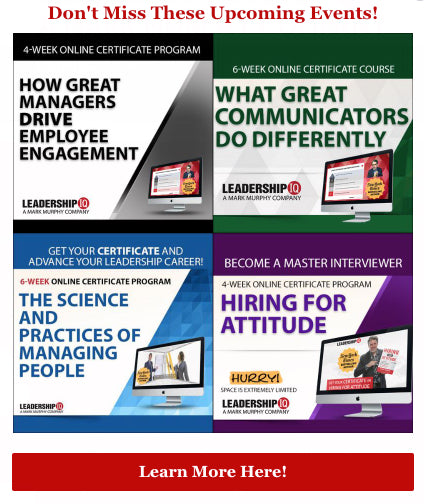The Secret To Employee Engagement Is Shoves And Tugs
This article originally appeared on Forbes by Mark Murphy, Founder of Leadership IQ
Here’s one of the most important lessons about employee engagement: Everybody has shoves and tugs. Shoves are those issues that demotivate you, drain your energy, stop you from giving maximum effort, and make you want to quit—they “shove” you out the door. Tugs are those issues that motivate and fulfill you, make you want to give maximum effort, and keep you coming back every day—they “tug” at you to stay.
This seems simple enough. But here’s the twist: shoves and tugs are not flip sides of the same coin. Just because somebody has lots of tugs coming up this week does not mean they don’t have any shoves. Before you spend all day trying to figure out how to give people lots of tugs, you’ve got to at least acknowledge (and ideally mitigate) their shoves. If you don’t, you’ll likely see the kinds of low employee engagement scores that have become so commonplace (you can see some of the latest employee engagement data here).
Let me begin with an analogy that’s a little out there but that might help clarify this issue. Just as shoves and tugs are not opposites, neither are pain and pleasure. The opposite of pleasure isn’t pain; it’s just the absence of pleasure. Similarly, the opposite of pain isn’t pleasure; it’s just the absence of pain. If somebody is hitting my foot with a hammer, that’s pain. When the hammering stops, that’s not pleasure; that’s just no more pain. If I’m getting the world’s greatest back rub, that’s pleasure. When it stops, that’s not pain; that’s just no more pleasure.
Here’s the lesson: If I’m getting a great back rub, that does not preclude somebody from simultaneously hitting my foot with a hammer. If that happens, the pain in my foot will totally detract from the pleasure I’m getting from the back rub. Here’s a corollary lesson: If you walk past me one day and see that my foot is being hit with a hammer, you cannot fix the pain in my foot by giving me a back rub. The only way to stop the pain in my foot is to stop the hammer from hitting it. And unfortunately, discovering those hammers hasn’t typically been something that employee engagement surveys look for.
Is Your Company Due for an Employee Engagement Survey?
Click Here to Learn More About Our Approach
Every day, in organizations around the world, employees’ feet are being hit with hammers, and their bosses’ solution isn’t to stop the hammer (i.e., eliminate the shove) but rather to offer a back rub (i.e., offer a tug). And, again, that’s a big reason why employee engagement scores (like these) continue to be so low.
Consider, for example, a software development team in Silicon Valley led by a manager named Chris. The department was on heavy deadline to finish a new product, and lately Chris’s anxiety had caused him to start micromanaging. He began instituting numerous “check in” meetings widely acknowledged as useless and insisting on regular “no-work team lunch hours” that forced high performing employees to work even later.
The high emotional tension throughout the department was clear to Chris. But rather than ask his team about the source of their frustration, Chris decided to take everyone to Catalina Island for the weekend to relax. He figured it was a great way to offer a nice reward and get everyone’s brains back into the game. When he made the announcement, more than a few of the programmers’ heads nearly exploded. The last thing they wanted was more time with one other just hanging out and not working. They wanted to finish the project, hit the deadline, and go home to their families. They wanted to stop wasting time at work and just get the job done.
Chris made the mistake of trying to fix a shove with a tug, and it backfired. Yes, Catalina Island is beautiful, and perhaps in another circumstance it would have been a nice reward and a way to boost employee engagement. But his team was getting shoved by too much time away from the actual work of programming, and here comes the boss with a tug that involves more time away from programming. Not only was the tug a poor choice, but Chris’s credibility is shot; he seems obtuse and insensitive for not understanding what was really demoralizing his team.
When good employees are working with low performers, or they’re fighting through roadblocks, or they’ve got a terrible working environment—whatever the shoves may be—it’s like getting hit on the foot with a hammer. Great things (tugs) like autonomy, the ability to have control over an entire process, and the ability to work on innovative projects and teams aren’t going to mean a thing until you take away the pain of the Shoves.
So if you want to see employee engagement improve, don’t just throw a bunch of tugs out there; really dig to discover the shoves.
Mark Murphy is a NY Times bestseller, author of Hiring For Attitude, and founder of Leadership IQ.









